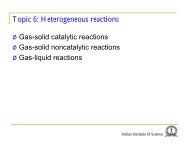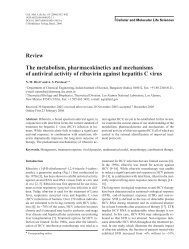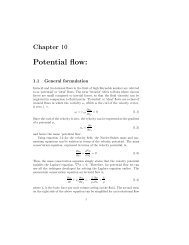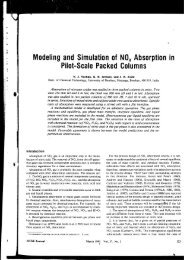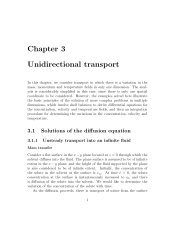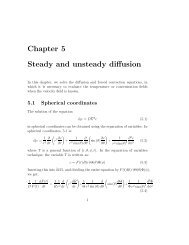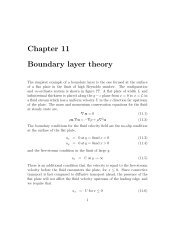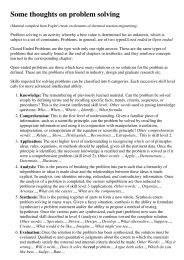You also want an ePaper? Increase the reach of your titles
YUMPU automatically turns print PDFs into web optimized ePapers that Google loves.
2 CHAPTER 9. VISCOUS FLOW<br />
The dimensionless number (ρUL/µ) is the Reynolds number, which provides<br />
the ratio of convection and diffusion for the fluid <strong>flow</strong>. This can also be<br />
written as (UL/ν), where nu = (µ/ρ) is the kinematic viscosity or momentum<br />
diffusivty.<br />
When the Reynolds number is small, the convective terms in the momentum<br />
equation 9.5 can be neglected in comparison to the viscous terms<br />
on the right side of 9.5. The Navier-Stokes equations reduce to the ‘Stokes<br />
equations’ in this limit,<br />
∂ i u i = 0 (9.6)<br />
−∂ i p + µ∂ 2 j u i = 0 (9.7)<br />
The Stokes equations have two important properties — they are linear, since<br />
both the equations are linear in the velocity u i , and they are quasi-steady,<br />
since there are no time derivatives in the Stokes equations. The absence of<br />
time derivatives in the governing equations implies that the velocity field<br />
due to the forces exerted on the fluid depend only on the instanteneous value<br />
of the forces, or the velocity boundary conditions at the surfaces bounding<br />
the fluid, and not the time history of the forces exerted on the fluid. For<br />
example, in order to determine the velocity field due to force exerted by a<br />
sphere falling through a fluid, it is sufficient to know the instanteneous value<br />
of the velocity of the sphere, and it is not necessary to know the details of<br />
the previous evolution of the velocity of the sphere. This is because the <strong>flow</strong><br />
is diffusion dominated, and it is assumed that diffusion is instanteneous at<br />
zero Reynolds number. A similar feature is encountered in the solution for<br />
the diffusion equation in the limit of low Peclet number, where convective<br />
effects are neglected.<br />
D∇ 2 c = 0 (9.8)<br />
In this case, the concentration field is determined at any instant if the value<br />
of the boundary conditions at the bounding surfaces are know, and it is not<br />
necessary to know the previous evolution of the previous evolution of the<br />
concentration at the bounding surfaces.<br />
Diffusion is not instanteneous in reality, of course, and there is a distance<br />
beyond which the assumption of instanteneous diffusion is not valid. For<br />
example, consider the case of a sphere settling through a fluid. Though<br />
diffusion is fast compared to convection over lengths comparable to the sphere<br />
diameter in the limit of low Reynolds number, it is expected that there is<br />
some larger length over which diffusion is not instanteneous, and convective



